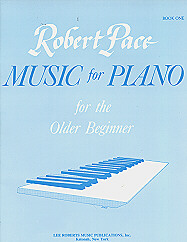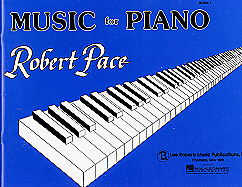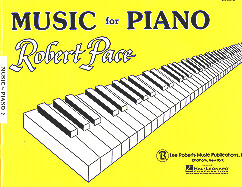|
 Music for the Piano
for the Older Beginner, Book One Music for the Piano
for the Older Beginner, Book One
by Robert Pace
The Pace Music for the Piano for the Older Beginner Book One is
a pedagogically sound aid for teaching the older beginner. It eschews the cute graphics
that intrigue children, but put off older beginners. Instead, the material is presented in
a concise and to-the-point manner. Thankfully, there is neither reference to nor
dependence upon position playing in this book. The repertoire found in this book consists
of American folk tunes, children's songs, and arrangements of classical repertoire such as
the New World Symphony by Antonin Dvorak.
Chords are discussed and shown using the figured bass patterns incorporating Roman
numerals, rather than employing the more contemporary chord notation of lower or upper
case letters. Students learn the root and inversions of chords and are taught to read and
understand tonic, subdominant, dominant, dominant 7th chords and secondary dominants.
Scales are written going up and down an entire octave. Students are also shown the
differences between parallel major and minor, relative major and minor, and corresponding
chordal progressions. Compositional terminology such as question and answer,
passing tones, and Alberti bass, as well as a brief glossary of additional musical terms,
are included in this volume.
This book does not "baby" the older beginner. The students who did a test
drive soon realized that they really had to think and apply themselves well to be able to
understand and successfully use it. Although the book is challenging, the only two
complaints that I received from students were that the music was a bit "old
fashioned" and they would like to have had more sight reading exercises and material.
No one could dispute the fact that students did learn, although Music for the Piano
for the Older Beginner Book One requires a lot of effort on the part of the
student and teacher. Considering its reasonable price, $4.95, this book does work.
 Theory Papers Book
I Theory Papers Book
I
Music for Piano Book I
Finger Builders Book I
Creative Music Book I
These "Pace method" books offer a no nonsense, concise and to the point
approach to learning piano and basics of music. Students who used these books appreciated
the fact that these books just got down to the point and spent little time "messing
around with baby stuff." The Forewords to each book explain very concisely the
author's approach to teaching musical notation - being able to decode the symbols on the
page to create certain sounds. The author's views are encapsulated nicely in a couple of
quotations: "This cognitive learning helps one transform symbols into sound through
certain split-second physical actions. Therefore one's reading skills will also be
dependent on effective physical coordination and aural discriminations...";
"here the emphasis is on the most effective and appropriate processes and the highest
quality experiences rather than the rote memorization of a few recital pieces to be
presented as the "product" at the spring recital. Students would perfect and
perform far more pieces if they in fact had better learning processes. Music as a genuine
aesthetic or "peak" experience is more than an exhibition of dexterity. It
affords opportunities for individuals to become the centers of their own creative
experience both in music and in the process of daily living." Teachers using these
books should NOT depend on them to spell out each and every detail of how to teach the
material. The Pace books count on the teacher being knowledgeable enough of the facts and
the learning processes of students to be able to work with their students in a cooperative
and supportive fashion to help students grow musically.
Theory Papers Book I begins with note name identification (on the piano
keyboard), then gets right into treble and bass clef reading, time and key signatures. I
liked the fact that theme and variations, sequence, question and answer, transposition,
identification of major and minor key signatures and triads, and discussion of the
"Alberti Bass" were included in this first book. The book gives students the
necessary information and then provides a lot of space on each individual page to do the
specific exercises and drills that help reinforce the concepts.
Music For Piano Book I covers such concepts as up and down, steps and
skips, recognizing the shape or "swing" of the melody, time signatures, flats
and sharps, and dynamics like forte, mezzo forte, staccato, and
legato touches. The pieces which reinforce these skills were not trivial. Students
who used this book enjoyed the music and, more to the point, enjoyed the fact that the
music was directly related to the ideas covered.
Like the other books in the Pace series, Finger Builders Book I
teaches strong technique in a down-to-earth, no-nonsense approach. Students are taught not
to daydream or approach the exercises mechanically, but, rather, to train themselves
thoughtfully. The beginning student does not have to read music initially to do these
exercises, as the notes to be used for the exercises are shown on the page along with
the different finger combinations. Students learn to be equally fluent in playing all
natural, sharp/flat note combinations and combinations of sharps, flats and naturals. Also
covered in Finger Builders Book I is contrary motion, producing forte
and piano while keeping technique under control, legato and staccato
studies which also incorporated crescendos and diminuendos, major and
minor broken arpeggios (broken between two hands), and a down/up study - designed to make
the first note of each group a little louder and the second note slightly softer and
slightly staccato.
Creative Music Book I has materials for sight reading, transposition,
and improvisation. The materials covered in this book are closely allied to those found in
Music For Piano. The student is urged to use those principles as
a springboard for further learning and discovery. The goal of Creative Music Book I is for
students to read and understand music at the level of their own unique experience and to
be able to create some of their own music. Students are encouraged to transpose as much as
they wish and to create musical examples of their own.
 Theory Papers Book 2 Theory Papers Book 2
Music For Piano Book 2
Finger Builders Book 2
Creative Music Book 2
Theory Papers Book 2 begins with a
short review of topics covered in Book I, then proceeds with a discussion of major, minor,
perfect and diminished intervals and triads, and chord progressions using the tonic (major
and minor), subdominant, and V7 chords. The information is very well organized and planned
and the student is given ample opportunity to do many exercises and drills to reinforce
these new concepts.
Music for the Piano Book 2 incorporates many 20th
century composition forms such as twelve-tone or serial writing. Also discussed are pedal
markings, chord colors, bi-chordal pieces of music, the Dorian mode, less common time
signatures such as 5/4, the pentatonic scale, the Phrygian mode, more examples of staccato
and legato playing, counting and dotted rhythmic patterns. The pieces in the book included
a number of enjoyable duets and ended with "Soldier's March" by Robert Schumann.
Finger Builders Book 2 stresses using different dynamic changes while
doing the exercises, for example, playing the exercises forte, then piano,
making a crescendo followed by a diminuendo and playing one hand forte
while the other hand plays piano. The exercises are also done with different
rhythms, different touches (legato to staccato and vice versa). Keeping
the elbow relaxed and quiet while working on wrist rotation AND passing the thumb under
the hand quickly and immediately when doing scales to avoid a bump or break in the scale
are important areas of technique which are emphasized. All major and minor scales are
covered along with very interesting and pedagogically/technically correct variants on
these scales
Finger Builders Book 2 includes fantastic practice ideas and topics
which many students are not exposed to until college, but should be incorporated into
their technique from the earliest stages. It is a wonderful resource for good practice
ideas and variants on scales and "Hanon-like" exercises. I deeply appreciated a
statement in the foreword of the book: "the conscientious teacher will help those
students form a practice program which will develop ever-increasing finger
control." Mr. Pace leaves it to the teacher to know their craft and the
learning patterns of each and every individual student so that the teacher can help the
individual to develop their technique and musical knowledge.
Creative Music Book 2 provides the necessary materials for the
continued development of good music reading and creative skills. The principles covered in
this book are the same as in Music for Piano and the Theory
Papers Books 2, but the student again uses these as a spring board for
expanding and creating as many variants as possible from the original concepts.
Each pair of facing pages contain examples which are conceptually the same, yet
slightly altered from those in Music for Piano Book 2, so that
the students continually bolster the previously learned material. The even numbered pages
provide related reading examples arranged in a cumulative order to help the student deal
effectively with progressively more complex music. The sight-reading material embodies
different key signatures, meters, and composition styles. The student is actively
encouraged to avoid looking at the keyboard when using notation, by looking at the music
and feeling where the hands should be placed. Material for the improvisational and
creative activities appears on the odd numbered pages. This uses a "Question and
Answer" format in which the student is given questions which provide the basic
musical ideas while the answers will be different with each individual student. This way,
all students can get a basic common musical knowledge and skill, yet are allowed to
develop their own individual creative styles.
The skills, principles, and theories presented in all of these books are musically and
pedagogically sound. I especially appreciated that these books assume (and require) the
knowledge and skill of a qualified teacher to work with each student as a unique
individual. My students surprised themselves not only in that they were able to learn so
much wonderful material in these books, but that they were able to begin to understand the
thought processes behind music by Bach, Schumann, Mozart and others.
Nancy Ostromencki
Music for the Piano for the Older Beginner Book One by Robert
Pace, list price $4.95. Published by the Lee Roberts Music Publications, Inc. Katonah, New
York. Theory Papers Book I by Robert Pace, list price $5.95. Music for Piano
Book I by Robert Pace, list price $5.95. Finger Builders Book I by Robert Pace,
list price $5.95. Creative Music Book I by Robert Pace, list price $5.95. Theory
Papers Book 2 by Robert Pace, list price $5.95. Music For Piano Book 2 by
Robert Pace, list price $5.95. Finger Builders Book 2 by Robert Pace, list price
$5.95. Creative Music Book 2 by Robert Pace, list price $5.95. All available from
Hal Leonard Corporation, 7777 West Bluemound Road, Milwaukee, WI 53213. Phone:
414-774-3630 Fax: 414-774-3259. E-mail: halinfo@halleonard.com. WWW: http://www.halleonard.com/ |
|


 Music for the Piano
for the Older Beginner, Book One
Music for the Piano
for the Older Beginner, Book One Theory Papers Book
I
Theory Papers Book
I Theory Papers Book 2
Theory Papers Book 2